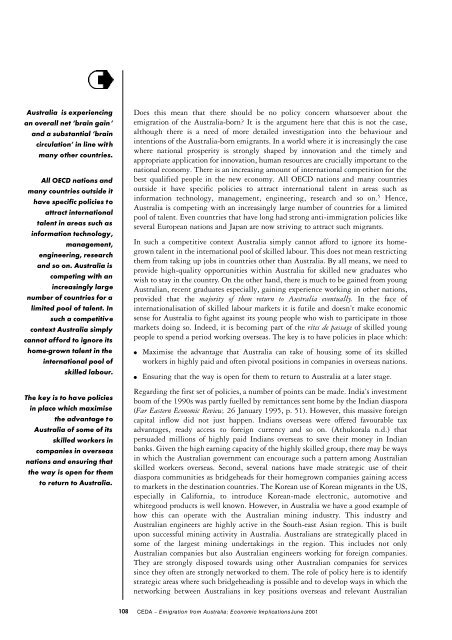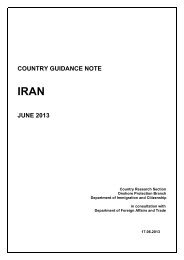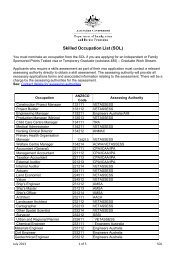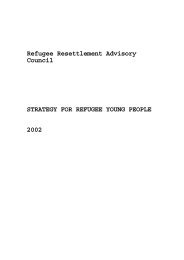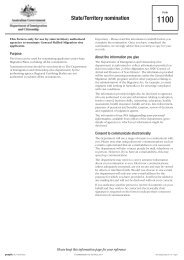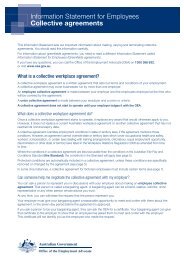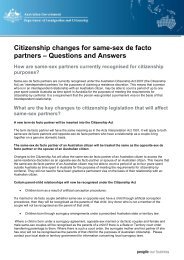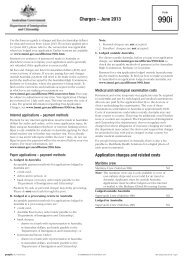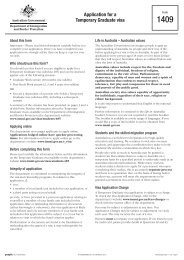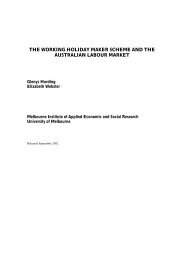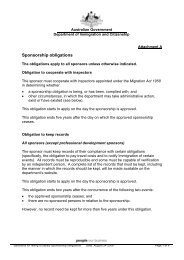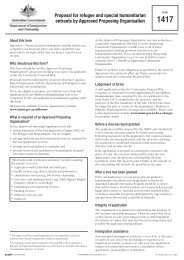part three - Department of Immigration & Citizenship
part three - Department of Immigration & Citizenship
part three - Department of Immigration & Citizenship
You also want an ePaper? Increase the reach of your titles
YUMPU automatically turns print PDFs into web optimized ePapers that Google loves.
Australia is experiencing<br />
an overall net ‘brain gain’<br />
and a substantial ‘brain<br />
circulation’ in line with<br />
many other countries.<br />
All OECD nations and<br />
many countries outside it<br />
have specific policies to<br />
attract international<br />
talent in areas such as<br />
information technology,<br />
management,<br />
engineering, research<br />
and so on. Australia is<br />
competing with an<br />
increasingly large<br />
number <strong>of</strong> countries for a<br />
limited pool <strong>of</strong> talent. In<br />
such a competitive<br />
context Australia simply<br />
cannot afford to ignore its<br />
home-grown talent in the<br />
international pool <strong>of</strong><br />
skilled labour.<br />
The key is to have policies<br />
in place which maximise<br />
the advantage to<br />
Australia <strong>of</strong> some <strong>of</strong> its<br />
skilled workers in<br />
companies in overseas<br />
nations and ensuring that<br />
the way is open for them<br />
to return to Australia.<br />
Does this mean that there should be no policy concern whatsoever about the<br />
emigration <strong>of</strong> the Australia-born? It is the argument here that this is not the case,<br />
although there is a need <strong>of</strong> more detailed investigation into the behaviour and<br />
intentions <strong>of</strong> the Australia-born emigrants. In a world where it is increasingly the case<br />
where national prosperity is strongly shaped by innovation and the timely and<br />
appropriate application for innovation, human resources are crucially important to the<br />
national economy. There is an increasing amount <strong>of</strong> international competition for the<br />
best qualified people in the new economy. All OECD nations and many countries<br />
outside it have specific policies to attract international talent in areas such as<br />
information technology, management, engineering, research and so on. 5 Hence,<br />
Australia is competing with an increasingly large number <strong>of</strong> countries for a limited<br />
pool <strong>of</strong> talent. Even countries that have long had strong anti-immigration policies like<br />
several European nations and Japan are now striving to attract such migrants.<br />
In such a competitive context Australia simply cannot afford to ignore its homegrown<br />
talent in the international pool <strong>of</strong> skilled labour. This does not mean restricting<br />
them from taking up jobs in countries other than Australia. By all means, we need to<br />
provide high-quality opportunities within Australia for skilled new graduates who<br />
wish to stay in the country. On the other hand, there is much to be gained from young<br />
Australian, recent graduates especially, gaining experience working in other nations,<br />
provided that the majority <strong>of</strong> them return to Australia eventually. In the face <strong>of</strong><br />
internationalisation <strong>of</strong> skilled labour markets it is futile and doesn’t make economic<br />
sense for Australia to fight against its young people who wish to <strong>part</strong>icipate in those<br />
markets doing so. Indeed, it is becoming <strong>part</strong> <strong>of</strong> the rites de passage <strong>of</strong> skilled young<br />
people to spend a period working overseas. The key is to have policies in place which:<br />
●<br />
●<br />
Maximise the advantage that Australia can take <strong>of</strong> housing some <strong>of</strong> its skilled<br />
workers in highly paid and <strong>of</strong>ten pivotal positions in companies in overseas nations.<br />
Ensuring that the way is open for them to return to Australia at a later stage.<br />
Regarding the first set <strong>of</strong> policies, a number <strong>of</strong> points can be made. India’s investment<br />
boom <strong>of</strong> the 1990s was <strong>part</strong>ly fuelled by remittances sent home by the Indian diaspora<br />
(Far Eastern Economic Review, 26 January 1995, p. 51). However, this massive foreign<br />
capital inflow did not just happen. Indians overseas were <strong>of</strong>fered favourable tax<br />
advantages, ready access to foreign currency and so on. (Athukorala n.d.) that<br />
persuaded millions <strong>of</strong> highly paid Indians overseas to save their money in Indian<br />
banks. Given the high earning capacity <strong>of</strong> the highly skilled group, there may be ways<br />
in which the Australian government can encourage such a pattern among Australian<br />
skilled workers overseas. Second, several nations have made strategic use <strong>of</strong> their<br />
diaspora communities as bridgeheads for their homegrown companies gaining access<br />
to markets in the destination countries. The Korean use <strong>of</strong> Korean migrants in the US,<br />
especially in California, to introduce Korean-made electronic, automotive and<br />
whitegood products is well known. However, in Australia we have a good example <strong>of</strong><br />
how this can operate with the Australian mining industry. This industry and<br />
Australian engineers are highly active in the South-east Asian region. This is built<br />
upon successful mining activity in Australia. Australians are strategically placed in<br />
some <strong>of</strong> the largest mining undertakings in the region. This includes not only<br />
Australian companies but also Australian engineers working for foreign companies.<br />
They are strongly disposed towards using other Australian companies for services<br />
since they <strong>of</strong>ten are strongly networked to them. The role <strong>of</strong> policy here is to identify<br />
strategic areas where such bridgeheading is possible and to develop ways in which the<br />
networking between Australians in key positions overseas and relevant Australian<br />
108 C E DA – Emigration from Australia: Economic ImplicationsJune 2001


